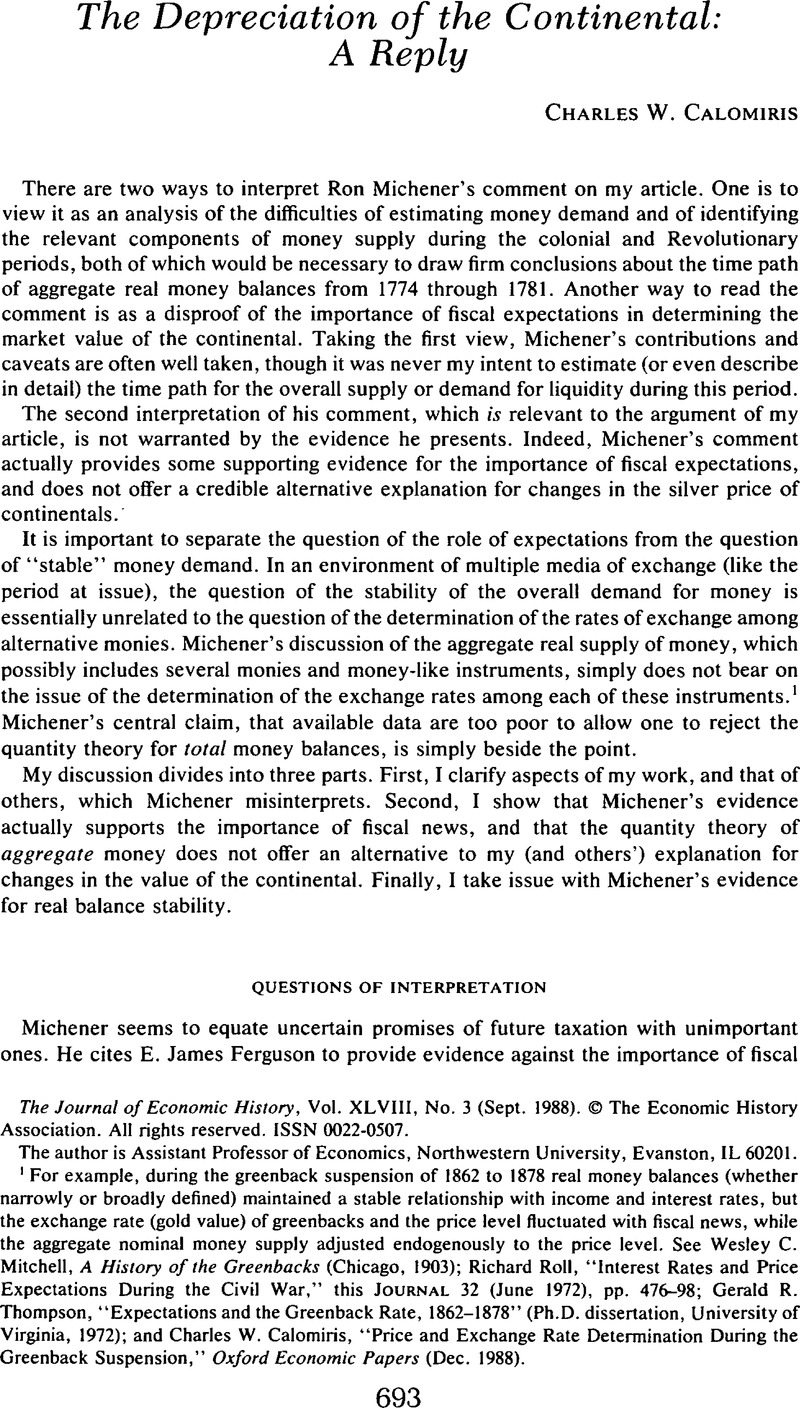Article contents
The Depreciation of the Continental: A Reply
Published online by Cambridge University Press: 03 March 2009
Abstract

- Type
- Notes and Discussion
- Information
- Copyright
- Copyright © The Economic History Association 1988
References
1 For example, during the greeback suspension of 1862 to 1878 real money balances (whether narrowly or broadly defined) maintaned a stable relationship with income and interest rates, but the exchange rate (gold value) of greenbacks and the price level fluctuated with fiscal news, while the aggreate nominal money supplu adjusted endogenously to the price level. See Westey, C. Mitchell, A History of the Greenbacks (Chicago, 1903)Google Scholar; Roll, Richard, “Interst Rates and Price Expectations During the Civil War,” this JOURNAL 32 (06 1972), pp. 476–98Google Scholar; R., Thompson Gerald, “Expectations and the Greenback Rate, 1862–1878” (Ph.D.dissertation,University of Virginia, 1972)Google Scholar; and Calomiris, Chatrles W., “Price and Exchange Rate Determination During the Greenback Suspension,” Oxford Economic Papers (12. 1988).Google Scholar
2 Ferguson, E. James, The Power of the Purse: A History of American Public Finance, 1776–1790 (Chapel Hill, 1961).Google Scholar
3 Ibid., p. 31.
4 See Catanzariti, John and Ferguson, E. James, eds., The Paper of Robert Morris (Pittsburgh, 1984), vol. 4, pp. 353–54.Google Scholar
5 It is hard to imagine what Michener has in mind when he writes: “Continental currency initially circulated as Par with specie. As issues multiplied in 1775/76, specie disappeared form circulation. With the displacement of specie, the par of exchange could no longer be maintained, and the continental began to float against other currencies (p. 683).” When a government pags the exchange rate between its currency and specie by promising convertibility upon demand, than depletions of the government's supply of specie can, as this passage suggests, make it impossible to maintan parity. The Continental Congress, however, never pegged continental-specie exchange rates in this way, and never horaded specia to ensure future convertibility. Thus, there was no connection between special flows out of the country and governmant backing of the currency. It is beyoud the scope of this reply to challenge more generally Michener's “customary fixed-exchangerate” view of colonial currency valuation. See Smith, Bruce D., “Money and Inflation in the American Colonies: Further Evidence on the Failure of the Quantity Theort” (unpublished manuscript, University of Western Ontario, 1987); and fn. 38 of my article. Parities in tax collection between paper currency, on the one hant, and specie or commodities, on the other hand, in some cases acted to “fix” exchange rates, though this is not the mechanism which Michener imagines. Examples of the operation of this mechanism are available upon request.Google Scholar
6 History is Full of Examples which contradict Gresham's supposed “law.” Currencies often have circulated at a premium alongside those of lesser market valu and equal face value. See Redish, Angela, “Why Was Specie Scarce in Colonial Economise? An Analysis of the Canadian Currency, 1796–1830,” this Journal, 44 (09. 1984), p. 718Google Scholar; Rolnick, Arthur J. and Weber, Warren E., “Gresham's Law or Gresham's Fallacy?” Journal of Political Economy, 94 (02. 1986), pp. 185–99CrossRefGoogle Scholar; Martin, David, “The Changing Role of Foreign Money in the United States, 1782–1857” this JOURNAL, 37 (12. 1977), pp. 1009–27Google Scholar; and Calomiris, Charles W., “Explaining Gresham's Law” (unpublished manuscript,Northwestern University, 1986)Google Scholar. Michener argues that legal tender laws may have driven specie from circulation, but available evidence indicates that Price contorls were not enforced. See Bolles, Albert, Financial History of the United States 1774–1789, (New York, 1883), pp. 158–89. Furthermore, continentals were driven out of criculation by mid-1781, a clear contradiction of Gresham's Law.Google Scholar
- 3
- Cited by


